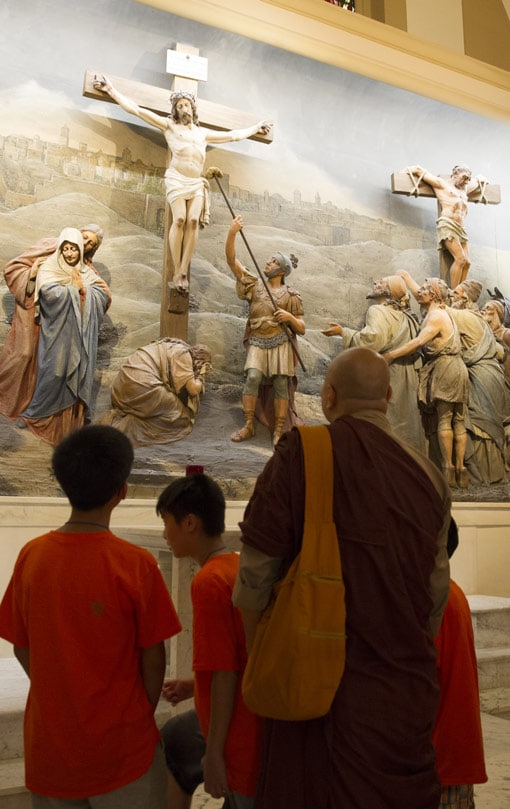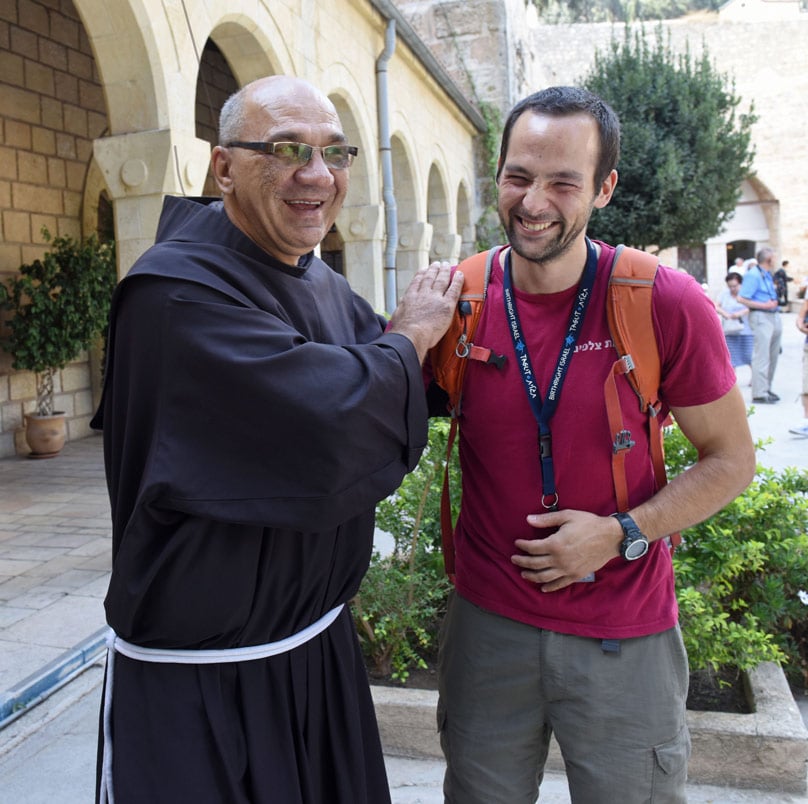
Last time, we saw that the Church to which Matthew writes has been grappling for decades with the question of the relationship of Jew and Gentile in the early Church, particularly in the Holy Land where Jewish ethnocentrism encouraged the idea that Jewish believers sit in first class while Gentile believers are second class and the proposition that “in Christ there is neither Jew nor Greek” is regarded with hostility and skepticism.
It is against this backdrop that Matthew relates the story of the Canaanite Woman. There are parallels to this story in other gospels, most notably that of Jesus’ encounter with the Samaritan Woman at the well (John 4). There too, Jesus meets a woman regarded as a foreigner and outsider. But so far from ignoring her, Jesus scandalizes his disciples by speaking with her. This calls into question my reader’s contention that Jesus feels himself bound by the notion that “an unrelated man and woman should not engage socially in public, all the more when the woman is a foreigner.”
Of course, the rejoinder is that the “Matthean Jesus” is not the “Johannine Jesus”. But I reject that approach. There is only one Jesus and all the gospels are relating things he said and did, albeit different things and in varying language for varying purposes. So the fact is Jesus had no trouble breaking social expectations regarding women and foreigners when he had a mind to do so.
And, as we have already seen, even the “Matthean Jesus” was willing to talk to Gentile Centurions and even willing to go to into their homes. So we need, I think, to look somewhere beside his alleged ethnocentrism for his actions with regard to the Canaanite Woman.
One thing I will grant my reader is that the conversation does partake fully of Jesus’ deeply Jewish and Middle Eastern love of badinage, argument, and riposte. As we saw back in Part 2, Jesus engages in it constantly. He bandies words with his disciples, he engages in clever arguments with those who, in their zeal to condemn him, pretend to care about paying taxes to Caesar and women taken in adultery. When somebody tries sophistry by asking “Who is my neighbor?” as a way to dodge responsibility, he responds with the Parable of the Good Samaritan (which, by the way, is not terribly ethnocentric). Even on trial for his life he deftly turns accusations like “Are you the King of the Jews?” into confessions with the artful reply “You have said it.”

And, of course, he does this most famously with his own mother in the scene at Cana when she too “bests” him in an exchange laden with enormous significance. Her request for wine is not mere “Mom hoping that My Son the Miracle Worker will impress the neighbors with drinks all around.” This is the Model Disciple importuning the Messiah to manifest himself, using precisely the kind of stubborn, importunate prayer he himself commands his disciples to use (Luke 11:5-13). That he understands this is clear from his response that his “hour” has not yet come. His “hour”, in John’s gospel, is his death. That will be the culmination of the mission she is asking him to inaugurate. The subtext of Jesus reply is, “Are you ready for this?” She persists, and he grants her prayer, performing the first great sign–a sign of the shedding of his Eucharistic blood. She “wins” this round of argument and riposte insofar as she chases Jesus till he catches her.
Something similar is happening, I believe, with the Canaanite Woman. Here is another peasant woman with, pardon the pun, dogged faith: as dogged as Mary’s and as dogged as the Gentile Centurion who, earlier in Matthew’s gospel, caused Jesus to marvel (Matthew 8:10).
Jesus can see her faith from the moment he lays eyes on her. Perhaps he can even see it from before the moment he lays eyes on her given his capacity for prophetic knowledge demonstrated in, for instance, his encounter with Nathanael (whom he saw under the fig tree before he was called, filling that disciple with astonishment [John 1:43-51]), or in his encounter with the Samaritan Woman who perceived that he was a prophet and was amazed that he “told me all that I ever did” (John 4:39). As I say, we cannot make hard and fast pronouncements about what Jesus does and does not know of the Canaanite Woman because of his unique mode of consciousness. But even unaided human reason, unblinded by any sin, could see that the Woman has faith in him and is determined to seek his help. She does, after all, call him “Lord” and “Son of David”, the great Messianic title. So I think it obvious that Jesus sees all that.
But his disciples cannot. All they see is a foreign woman because, as my reader rightly notes, that is what first century Jewish ethnocentrism taught them to see just as it is all it taught them to see in the Samaritan woman. And it is all Matthew’s audience of Judean Christians have been taught to see about Gentiles until the day of their baptism. Moreover, it is something they are still slow to learn after their baptism. Matthew, however, aims to communicate to his audience what Jesus taught his apostles that day. He writes:
And Jesus went away from there and withdrew to the district of Tyre and Sidon. And behold, a Canaanite woman from that region came out and cried, “Have mercy on me, O Lord, Son of David; my daughter is severely possessed by a demon.” But he did not answer her a word. And his disciples came and begged him, saying, “Send her away, for she is crying after us.” He answered, “I was sent only to the lost sheep of the house of Israel.” But she came and knelt before him, saying, “Lord, help me.” And he answered, “It is not fair to take the children’s bread and throw it to the dogs.” She said, “Yes, Lord, yet even the dogs eat the crumbs that fall from their masters’ table.” Then Jesus answered her, “O woman, great is your faith! Let it be done for you as you desire.” And her daughter was healed instantly. (Mt 15:21–28)

Instead of imagining this exchange as taking place in a tone of contemptuous dismissal by Jesus and fawning begging from the Canaanite Woman, I think it more likely that Jesus is keeping one eye on the apostles (who have a very definite expectation of how this conversation should go) and his other eye on the Woman for whom he feels not ethnocentric contempt but delight and (as with the Centurion) a sense of marveling. His initial silence is a test, not of her, but of his disciples. He gives them space to respond–and they fail spectacularly much as they failed when women brought Jesus their children for him to bless. They demand he send her away.
So he repeats to her what he has already told them, that he is sent only to the lost sheep of the house of Israel. But he does so not to drive her away (imagine it spoken with a wry smile and one eye on the apostles and not a cold tone of dismissal) but to give her space to respond–and she succeeds spectacularly. She refuses to back down, places herself in his path and on her knees and, with as much wit and ingenuity as any reply he ever made to an interlocutor, “beats” him at the game of badinage just as Mary did at the wedding at Cana. And again, he marvels.
A word about that, by the way: marveling may include a sense of surprise. So it is possible, certainly, that she did surprise him with her faith. But it is just as possible that she did not surprise him a bit since we can and do marvel at things without being surprised by them. From the sight of the Milky Way, to the awe of childbirth, to the wonders performed by magician, human beings can be completely unsurprised, yet experience amazement and marveling all the same. It is entirely possible that Jesus’ amazement at the woman has that quality as well. And I think that is exactly what is going on here.
I see Jesus in this scene delighting in this Woman, not treating her with ethnocentric contempt. I think virtually every line he delivers is spoken, not for her benefit, but for the band of disciples who are sure they have everything figured out and who are certain that their mission will forever be only to the house of Israel. That’s why they want to send her away and that is exactly why Jesus gives her the space to express her faith with such doggedness. He is not insulting or ignoring her. He is revealing her (and his delight in her) to his disciples and putting their ethnocentrism to shame, not sharing in it.
It remains a vital lesson in an age where the Church is still struggling with the sin of racism and still failing to grasp that, “in Christ Jesus you are all sons of God, through faith. For as many of you as were baptized into Christ have put on Christ. There is neither Jew nor Greek, there is neither slave nor free, there is neither male nor female; for you are all one in Christ Jesus. And if you are Christ’s, then you are Abraham’s offspring, heirs according to promise” (Galatians 3:26-29).
